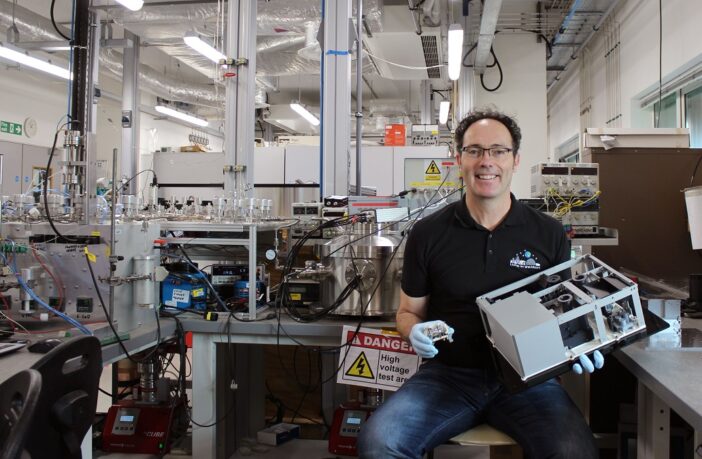Peregrine Mission One will begin its journey from Florida to the Moon no earlier than January 8, 2024, on a historic mission that will pave the way for future exploration and long-term human presence in space.
Onboard will be the Peregrine Ion Trap Mass Spectrometer (PITMS), which was developed in partnership between The Open University (OU), ESA, NASA Goddard Space Flight Center and Science Technology Facilities Council (STFC) RAL Space, the UK’s national space lab.
The PITMS instrument is based on a mass spectrometer (the EMS – exospheric mass spectrometer) developed by Dr Simeon Barber of the OU with support of £14 million through the UK Space Agency’s membership of the European Space Agency.
The spectrometer will analyse the incredibly thin atmosphere near the lunar surface, and study how water might be moving around the Moon today. The experiment is a pathfinder for future missions to the lunar poles where these molecules may become frozen in sufficient quantities to produce drinking water for astronauts.
Making good use of resources found locally on the Moon reduces our dependence on carrying all mission supplies from Earth and could be key to unlocking a more sustainable way of exploring space.
PITMS is a NASA-Provided Payload (Principal Investigator: Dr. Barbara Cohen, NASA Goddard Space Flight Center) being delivered to the Moon via NASA’s Commercial Lunar Payload Services initiative, with Peregrine being built and operated by Pittsburgh-based Astrobotic Technology.
Dr Simeon Barber, The Open University, said:
“PITMS will allow us to study the lunar water cycle and understand how a spacecraft interacts with the lunar surface and atmosphere. NASA’s Commercial Lunar Payload Services initiative is hugely exciting for lunar scientists, as it offers lots of opportunities to put new instruments on the Moon and do great science.”
Libby Jackson, Head of Space Exploration at the UK Space Agency, said:
“The Peregrine Lunar Lander will help pave the way for further exploration of our Solar System.
“Witnessing the first instrument from the UK, and indeed Europe, launch to the Moon is a hugely exciting moment. We are looking forward to seeing Peregrine safely on the surface and the return of important data from PITMS to help unlock the secrets of water on the moon.
“It’s fantastic to see our skilled UK experts at the heart of an international mission that will support future long-term presence in space.”
Chris Howe, Production and Software Group Leader at STFC RAL Space:
“The utilisation of the moon’s water could prove vital for future human endeavours in space, so we’re incredibly proud to have had the opportunity to help develop PITMS and are delighted to see safely on its way.
The technology from PITMS will now help underpin future missions, such as the Rosalind Frankin Rover, so whilst PITMS will only operate for one lunar day on the moon, its legacy will be felt for years.”
The launch is scheduled to take place from Cape Canaveral. You can watch from home on NASA’s website.



